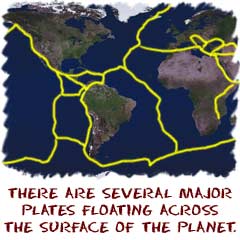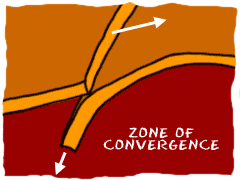Plates Are Moving Beneath You
 The basic idea behind plate tectonics is that there are eight major plates on the surface of the Earth. There are also bunches of minor plates. The plates are like the skin of the planet. They constantly move around the planet. When we say constantly moving, we're talking centimeters each year. You couldn't sit down and watch it happen. Or can you? You could watch it happen if you watched an earthquake.
The basic idea behind plate tectonics is that there are eight major plates on the surface of the Earth. There are also bunches of minor plates. The plates are like the skin of the planet. They constantly move around the planet. When we say constantly moving, we're talking centimeters each year. You couldn't sit down and watch it happen. Or can you? You could watch it happen if you watched an earthquake.
They Really Float?
These plates make up the top layer of the Earth called the lithosphere. Directly under that layer is the asthenosphere. It's a flowing area of molten rock. There is constant heat and radiation given off from the center of the Earth. That energy is what constantly heats the rocks and melts them. The tectonic plates are floating on top of the molten rock and moving around the planet. Think of it as ice floating at the top of your soda. When the continents and plates move it's called continental drift. Think of the molten rock in the asthenosphere, not as rock, but as a liquid. It has currents and it flows just like any other liquid. When the floating plates spread apart, it's called a spreading center. When they are moving together, it's called a subduction zone. When they are forced together, it is called a zone of convergence. One of the plates usually moves under the other in a zone of convergence. As the plate moves down into the asthenosphere it begins to melt. The place where they meet has a crack or a trench. Some of the deepest parts of the oceans are these trenches.
Think of the molten rock in the asthenosphere, not as rock, but as a liquid. It has currents and it flows just like any other liquid. When the floating plates spread apart, it's called a spreading center. When they are moving together, it's called a subduction zone. When they are forced together, it is called a zone of convergence. One of the plates usually moves under the other in a zone of convergence. As the plate moves down into the asthenosphere it begins to melt. The place where they meet has a crack or a trench. Some of the deepest parts of the oceans are these trenches.
Scientific Evidence
 How do we back up these ideas? Scientists have traveled all over the Earth and found evidence that supports the ideas of plate tectonics. First, they looked at the continents. Ever notice how Africa and South America look like they could fit together? Scientists did. They cut up a map, moved the continents close together, and came up with a huge landmass called Pangaea (one super-continent).
How do we back up these ideas? Scientists have traveled all over the Earth and found evidence that supports the ideas of plate tectonics. First, they looked at the continents. Ever notice how Africa and South America look like they could fit together? Scientists did. They cut up a map, moved the continents close together, and came up with a huge landmass called Pangaea (one super-continent).
Scientists also looked at the fossils (long-dead animal bones and plants) on the different continents. They found that fossils on Australia were similar to the ones in Southern Asia. They think the same plants once lived on the continents, but when they split apart, new plants developed. When they were digging, they also looked at the types of rocks. The West Coast of Africa has very similar rock formations to those on the East Coast of South America. They are too similar to be a coincidence.
Or search the sites for a specific topic.
- Overview
- Composition
- Magnetic Field
- Structure
- Rock Types
- Tectonics
- Faulting
- Earthquakes
- Volcanoes
- More Topics

Fossils and Plate Tectonics (NASA SciFiles Video)

Useful Reference Materials
Encyclopedia.com (Plate Tectonics):http://www.encyclopedia.com/topic/plate_tectonics.aspx
Wikipedia:
http://en.wikipedia.org/wiki/Plate_tectonics
Encyclopædia Britannica:
http://www.britannica.com/EBchecked/topic/463912/plate-tectonics





